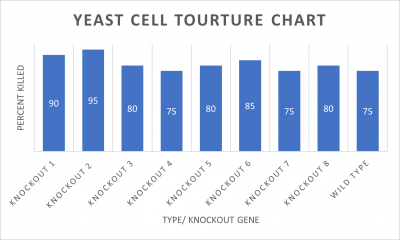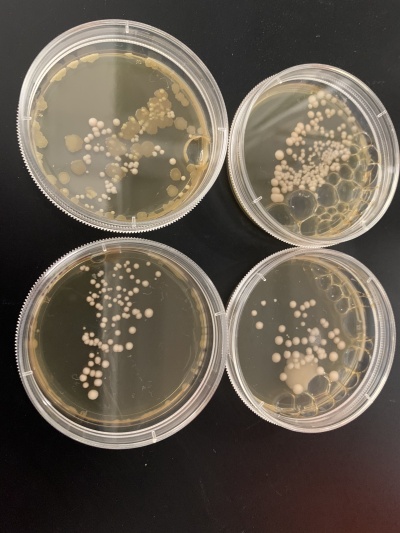UW-Stout/UV Light SP22
Contents
Materials
- Phosphate Buffered Saline (PBS)
- Growth Media (Agarose)
- Yeast Strains, Knockouts and Wild Type
Equipment
- P-1000 Micro-pipette
- P-20 Micro-pipette
- Bachur & Associates Santa Clara, CA 95050 Model LS-100-3 UV Light Exposure System (400 Watts)
- Incubator set to 30°C
- Fine Tip Sharpie
- 60mm Culture Dish
Calibration Protocol
- Make sure to have the right protection when handling anything during the experiment
- Around the Lab
- Lab Coat
- Gloves
- In the Clean Room
- Hair Net
- Booties
- Zip-Up Lab Coat
- Gloves
- Around the Lab
- Fill Micropipette tubes with 100 cells of your yeast gene choice
- Pipette X amount of wild yeast stock into X amount of PBS
Calibration Results
- For calibration trial 1 we ran 10 plates at varying times of 1, 3, 5, 10, 20, 50, 100, 200, 500, and 1000 seconds. We counted the colonies after giving the yeast time to grow.
- Results
- 1 second
- 3 seconds
- 5 seconds
- 10 seconds
- 20 seconds
- 50 seconds
- 100 seconds
- 200 seconds
- 500 seconds
- 1000 seconds
- Interpretation
- Interpretation: Even at 500 seconds, there were still a lot of yeast colonies, meaning 500 seconds likely wasn't long enough to stress the yeast cells as desired. A couple of outliers had very few colonies despite not being under the UV light for very long. This was likely because the plates didn't have the desired number of cells since it is impossible to tell exactly how many cells are on the plate until they've had time to grow.
- For calibration trial 2 we ran 9 plates at varying times of 550, 600, 650, 700, 750, 800, 850, 900, and 950 seconds. After giving the yeast time to grow in the incubator we counted the colonies on each plate.
- Results
- Pilot Experiment April 19, 2022
- 550 seconds = 483 colonies
- 600 seconds = 279 colonies
- 650 seconds = 198 colonies
- 700 seconds = 40 colonies
- 750 seconds = 54 colonies
- 800seconds = 13 colonies
- 850 seconds = 4 colonies
- 900 seconds = 2 colonies
- 950 seconds = 1 colony
Knock-out Protocol
- Wear Proper PPE when handling Yeast Cells, avoid direct exposure to UV light, and wear safety glasses if needed.
- Fill 7 1.5ml centrifuge tubes with 9,990ul of PBS.
- Vortex each yeast stock to resuspend the yeast cells. (wild and 6 knock-out strains)
- Pipette 10ul of each individual yeast stock into one of the centrifuge tubes containing 9,990ul of PBS to create a dilution containing 2 yeast cells per microliter for each strain. Make sure to label each tube, so the strains don't get mixed up.
- Vortex each dilution and prepare 14 plates to total, two for each yeast strain with 50ul of the yeast dilution for about 100 yeast cells per plate.
- Label 7 plates with 0 and the other 7 plates with 600 for the number of seconds each plate will be exposed to the UV light. Also, label what yeast strain is in each plate. There should be a 0 plate and 600 plates for each strain.
- Set up the UV light exposure system:
- 400 watts
- 600 Seconds
- Run yeast plates (without plate top) under the UV light for their respective times in seconds.
- Place plates upside down in a dark incubator set to 30°C for 48 hours.
- Count the number of colonies on each plate using the 0-second plate as your control to compare to. Based on how many colonies there are on each plate, determine if the knocked-out gene of the yeast had any effect on the survival of the yeast cells (improved/reduced survival).
- Repeat the procedure above as needed to acquire the data required.
Knock-out Results
- Knock-out Strain 1:YDL109C
- Knock-out Strain 2:YGL146C
- Knock-out Strain 3:YOR111W
- Knock-out Strain 4:YHL029C
- Knock-out Strain 5:YDR307W
- Knock-out Strain 6:YNL058C
- Knock-out Strain 7:YCL049C
- Knock-out Strain 8:YGR079W
Wild type
Results:
- Experiment 1
- 0sec = 24 colonies
- 600sec = 58 colonies
- Experiment 2
- 0sec = 95 colonies
- 600sec = 92 colonies
Interpretation: The two 0sec plates are on top, and the 600sec plates are on the bottom. I believe something went wrong with the wild strain run. The 0sec plat had fewer than the plate exposed to the UV light for 600sec, and the second run didn't seem to be affected much by the UV light. I guess that the number of cells each plate had, in the beginning, was significantly different, making it hard for this data to be used reliably.
Photos
- https://photos.app.goo.gl/MHK9qHdCcy15Z5JF8
- YGL146C
- 1 second
- 60 seconds

